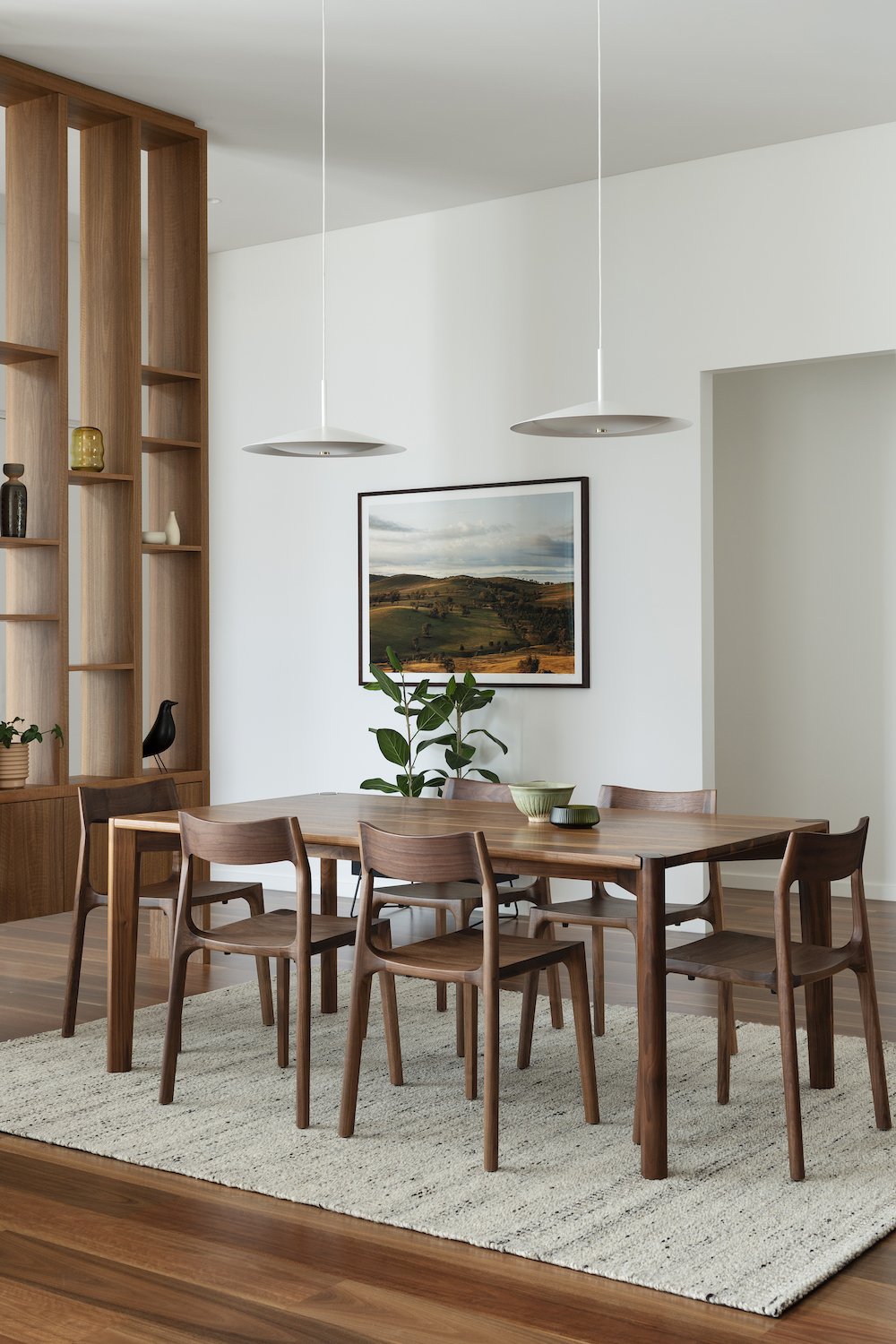Finer Dining
How to design a special space for sit-down meals in an open-plan setting.
In partnership with LOAM • Photography DMAX PHOTOGRAPHY • Story ELIZABETH CLARKE
The exquisite craftsmanship of the Froxfield Dining Table by local maker Nathan Day makes a handsome addition to any dining space.
The space in your home where you entertain guests or share a special meal is not just a table and chairs. It's a place that holds the warmth of family togetherness, the joy of spending time with friends, and the excitement of sharing stories, experiences and ideas.
So where do you place your dining table if you don't have a designated room? The open kitchen-dining-living layout, while popular, presents a unique challenge. Can you create an intimate dining experience even when it's near the kitchen and serves as a drop zone for life admin, keys and empty coffee cups?
A dining zone in an open plan is a great opportunity to make a strong design statement and add character to your space. While it is an extension of the kitchen and living room, the dining area can have a personality all its own. In fact, making it a focal point can transform the look and feel of your home.
Table and Chairs
Choose a table made of material that effortlessly blends with its surroundings to create a captivating space. Loam selected the Froxfield dining table by local maker Nathan Day in walnut, which matches the walls surrounding it. "It's fine to mismatch your timbers, but in a large open space, creating a seamless timber palette makes it feel capacious, calmer, and tidier," says interior designer Lulu Cavanagh from Loam.
As a modern take on the early 1900s refectory table, Nathan handcrafted the Froxfield dining table in his Margaret River studio. Finding inspiration in the Hay Rake dining tables crafted by Froxfield’s English pioneers, Nathan crafted shapely curves and interlocking timber joinery, a study in precision and sturdiness. The table’s size and artisanal craftsmanship make it a natural focal point, and its accompanying chairs further draw the eye.
When choosing dining chairs, carefully consider form and proportions. Look for shapes in the table and surrounding architecture, such as arches and angular floor-to-ceiling windows, and let them inform your choice of chair. For example, the Froxfield dining table is very linear, but its legs culminate in beautiful curves at each end, making TIDE’s Lumi chair, which features straight and sweeping lines, the perfect match. Handcrafted by TIDE’s maker, George Harper, the Lumi chair combines the very best of traditional and contemporary artisanal techniques. Its soft curves, straight lines and angles make for a discreet yet dynamic visual.
Lighting
Good lighting is essential for creating the perfect atmosphere, the ultimate goal of a beautiful dining space. Lighting can draw attention to a dining suite in an open-plan space, injecting depth, dimension and drama. It also clearly distinguishes the dining area from its surrounding spaces, giving it a more purposeful and deliberate feel.
Soft, warm lighting, whether from a table lamp or candles, has a magical ability to conjure a cosy and inviting atmosphere, drawing people around the table and encouraging them to relax and unwind. "I love to place sculptural candles on a dining table not just for soft, flattering light but as art forms," says Lulu, who has a particular penchant for pure beeswax candles by Tony Assness. "Each one is hand-poured in Bondi [Sydney] and has a sweet, subtle honey scent."
Choose from traditional pillar candles, wax bowls with an internal candle, large ribbed wax sculptures or small egg-shaped designs. Place one at the centre of the table or cluster several together, remembering that when styling, a grouping of three objects looks most impactful.
Styling
Experiment with metallic and organic elements for a dining setting in an open-plan space. Take a minimalist approach with a single metallic centrepiece. For a more eclectic style, Loam recommends layering metallic and natural elements like bowls, flowers, fruit and candles.
"A favourite object of mine is 101 Copenhagen's hand-glazed Ruin vase, inspired by archetypical ruins," Lulu says. “It is the perfect decorative vessel for plants, with its tower-like design offering various openings that hide and reveal foliage while providing room to grow."
Alternatively, Tom Dixon's extra-large Bone bowl looks beautiful on its own or filled with pomegranates, and being brass, patinas elegantly with time.
These three-legged vessels are as playful as they are practical. Duck Plate, Big-Coffee by 101 Cophenhagen Home, $390, Loam.
A beautiful, mouth-blown vase imbues an organic quality to your styling. Ostrea Rock Glass vase in rush, $330, Loam.
Inspired by floral shapes, this vase changes appearance throughout the day, according to light and shadows. Bloom vase by 101 Copenhagen Home, $390, Loam.
Sculptural like a Lotus flower, this beautiful curvy vessel looks perfect perched on a similarly dark table or a timber surface. Lotus vase by 101 Copenhagen Home, $471, Loam.
Beautiful objects elevate a well-designed space. Froxfield dining table by local maker Nathan Day, POA, and Lumi chairs by TIDE Design, from $1,197, from Loam. On table left to right. Taper candles by Tony Assness, from $75; 101 Copenhagen Home Ruin vase, $220; Tom Dixon Eclectic Root candle, $199, all from Loam. On sideboard. Tom Dixon Bone bowl, from $255, Loam.










